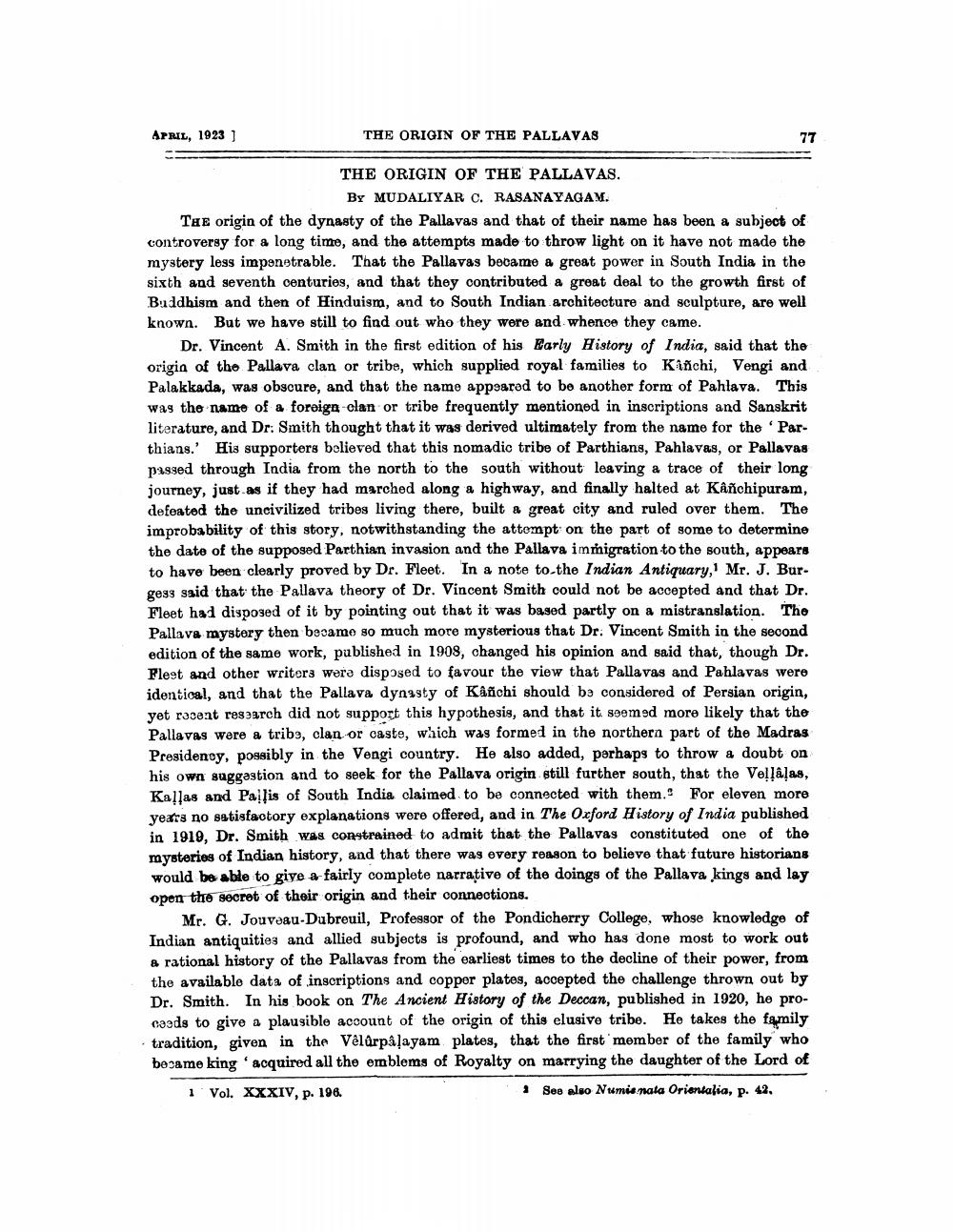________________
APRIL, 1923 ]
THE ORIGIN OF THE PALLAVAS
77
THE ORIGIN OF THE PALLAVAS. BY MUDALIYAR C. RASANAYAGAM.
THE origin of the dynasty of the Pallavas and that of their name has been a subject of controversy for a long time, and the attempts made to throw light on it have not made the mystery less impenetrable. That the Pallavas became a great power in South India in the sixth and seventh centuries, and that they contributed a great deal to the growth first of Buddhism and then of Hinduism, and to South Indian architecture and sculpture, are well known. But we have still to find out who they were and whence they came.
Dr. Vincent A. Smith in the first edition of his Early History of India, said that the origin of the Pallava clan or tribe, which supplied royal families to Kiñchi, Vengi and Palakkada, was obscure, and that the name appeared to be another form of Pahlava. This was the name of a foreign clan or tribe frequently mentioned in inscriptions and Sanskrit literature, and Dr. Smith thought that it was derived ultimately from the name for the 'Parthians.' His supporters believed that this nomadic tribe of Parthians, Pahlavas, or Pallavas passed through India from the north to the south without leaving a trace of their long journey, just as if they had marched along a highway, and finally halted at Kâñchipuram, defeated the uncivilized tribes living there, built a great city and ruled over them. The improbability of this story, notwithstanding the attempt on the part of some to determine the date of the supposed Parthian invasion and the Pallava immigration to the south, appears to have been clearly proved by Dr. Fleet. In a note to the Indian Antiquary, Mr. J. Burgess said that the Pallava theory of Dr. Vincent Smith could not be accepted and that Dr. Fleet had disposed of it by pointing out that it was based partly on a mistranslation. The Pallava mystery then became so much more mysterious that Dr. Vincent Smith in the second edition of the same work, published in 1908, changed his opinion and said that, though Dr. Flest and other writers were disposed to favour the view that Pallavas and Pahlavas were identical, and that the Pallava dynasty of Kâñichi should be considered of Persian origin, yet recent research did not support this hypothesis, and that it seemed more likely that the Pallavas were a tribe, clan or caste, which was formed in the northern part of the Madras Presidency, possibly in the Vengi country. He also added, perhaps to throw a doubt on his own suggestion and to seek for the Pallava origin still further south, that the Vellâļas, Kallas and Pallis of South India claimed to be connected with them. For eleven more years no satisfactory explanations were offered, and in The Oxford History of India published in 1919, Dr. Smith was constrained to admit that the Pallavas constituted one of the mysteries of Indian history, and that there was every reason to believe that future historians would be able to give a fairly complete narrative of the doings of the Pallava kings and lay open the secret of their origin and their connections.
Mr. G. Jouveau-Dubreuil, Professor of the Pondicherry College, whose knowledge of Indian antiquities and allied subjects is profound, and who has done most to work out a rational history of the Pallavas from the earliest times to the decline of their power, from the available data of inscriptions and copper plates, accepted the challenge thrown out by Dr. Smith. In his book on The Ancient History of the Deccan, published in 1920, he proceeds to give a plausible account of the origin of this elusive tribe. He takes the family tradition, given in the Vêlûrpâlayam plates, that the first member of the family who became king acquired all the emblems of Royalty on marrying the daughter of the Lord of See also Numismata Orientalia, p. 42.
1 Vol. XXXIV, p. 196.




